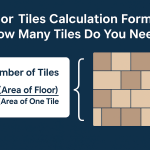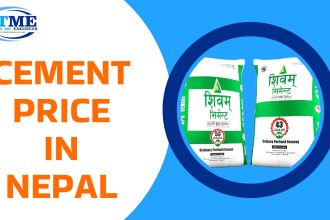Are you planning to lay tiles over a 200 sq ft floor area and wondering how much cement is needed? Whether you are a civil engineer, contractor, understanding how to calculate cement for tile 200 sq ft floor area is crucial for both budgeting and achieving quality workmanship.
In this detailed guide, we’ll walk through the step-by-step calculation of cement required for floor tile installation, including assumptions, formulas, and practical advice. Let’s dive right into the essential details.
Why It’s Important to Calculate Cement for Floor Tiles Accurately.
Before we dive into the numbers, here’s why an accurate cement calculation for tile work matters:
- ✅ Ensures better bonding of tiles with the surface
- ✅ Helps avoid wastage and unexpected cost overruns
- ✅ Ensures durability and long-term performance of the flooring
- ✅ Assists in ordering the correct amount of tile flooring materials
Assumptions for the Calculation
To calculate the amount of cement for a 200 sq ft floor tile area, we need to define a few key parameters:
- Total floor area = 200 sq ft
- Mortar mix ratio (cement: sand) = 1:3
- Mortar thickness = 2 inches = 0.167 ft
- Extra cement for adhesion = 20%
- 1 cement bag volume = 1.226 cubic feet
📌 Note: These values are typical and may vary based on tile size, substrate condition, and method of application.
Step-by-Step: Calculate Cement for Tile 200 sq ft Floor Area
Let’s go through the full cement quantity calculation in an easy and clear format:
Step 1: Calculate Wet Volume of Mortar
The wet volume is the actual space the mortar will occupy below the tiles.
Wet Volume (Vw) = Floor Area × Mortar Thickness
= 200 sq ft × 0.167 ft
= 33.4 cubic feetStep 2: Convert Wet Volume to Dry Volume
Since materials shrink after mixing and setting, we increase the wet volume by 33% to get the dry volume.
Dry Volume (Vd) = Wet Volume + 33% of Wet Volume
= 33.4 + (0.33 × 33.4)
= 33.4 + 11.02
= 44.42 cubic feetStep 3: Cement Quantity from Mortar Mix Ratio
We are using a 1:3 cement mortar ratio for tiles, so:
- Total parts = 1 + 3 = 4
- Cement’s part = 1/4 of the dry volume
Cement Volume = 1/4 × 44.42 = 11.105 cubic feetAdd 20% extra cement for better tile bonding.
Extra Cement = 20% of 11.105 = 2.22 cubic feet
Total Cement = 11.105 + 2.22 = 13.325 cubic feetStep 4: Convert Volume to Bags
We know:
- 1 bag of cement = 1.226 cubic feet
So,
Required Bags = 13.325 ÷ 1.226 ≈ 10.87 bags👉 Final Answer: You will need approximately 11 bags of cement for tiling a 200 sq ft floor area.
Cement Requirement Summary Table
| Description | Quantity |
|---|---|
| Floor Area | 200 sq ft |
| Mortar Thickness | 2 inches (0.167 ft) |
| Dry Volume of Mortar | 44.42 cubic feet |
| Cement Needed (before extra) | 11.105 cubic feet |
| Extra Cement (20%) | 2.22 cubic feet |
| Total Cement Volume | 13.325 cubic feet |
| Cement Bags Required | ≈ 11 Bags |
Pro Tips for Better Tile Work
- Use quality cement and sand: A strong mortar ensures tiles won’t loosen over time.
- Maintain consistency in mix ratio to avoid cracks.
- Tile fixing mortar thickness should be uniform for a smooth finish.
- Wet the surface before applying mortar for better bonding.
- Consider using ready-mix tile adhesive for faster and cleaner application in modern projects.
Related Questions Answered 🔗
How much sand is needed for tile work?
Using a 1:3 ratio, you’ll need 3 parts sand for every 1 part of cement. For this case:
- Total Sand = 3/4 × 44.42 = 33.315 cubic feet
Add 20% extra for losses. - Total = ~40 cubic feet of sand
Can I use tile adhesive instead of cement mortar?
Yes. For smaller areas or thin tiles, ready-made tile adhesive is recommended. It offers better grip and requires no sand or water mixing.
Conclusion
Now you know exactly how to calculate cement for tile 200 sq ft floor area. For a standard 1:3 cement mortar mix with 2-inch thickness, you’ll need approximately 11 bags of cement. This estimate includes a 20% extra margin to ensure strong bonding and coverage.
Whether you’re renovating your home or working on a construction site, proper planning saves time, effort, and money.












